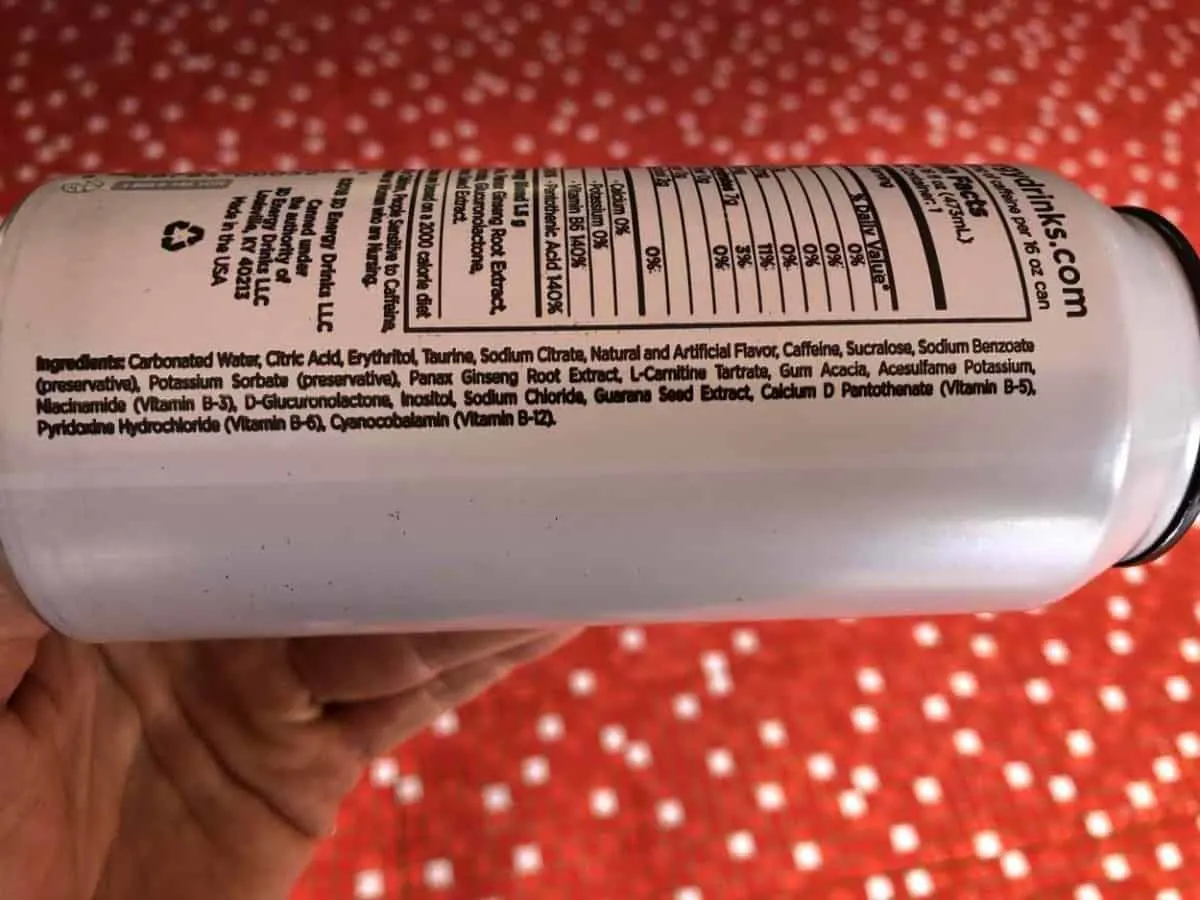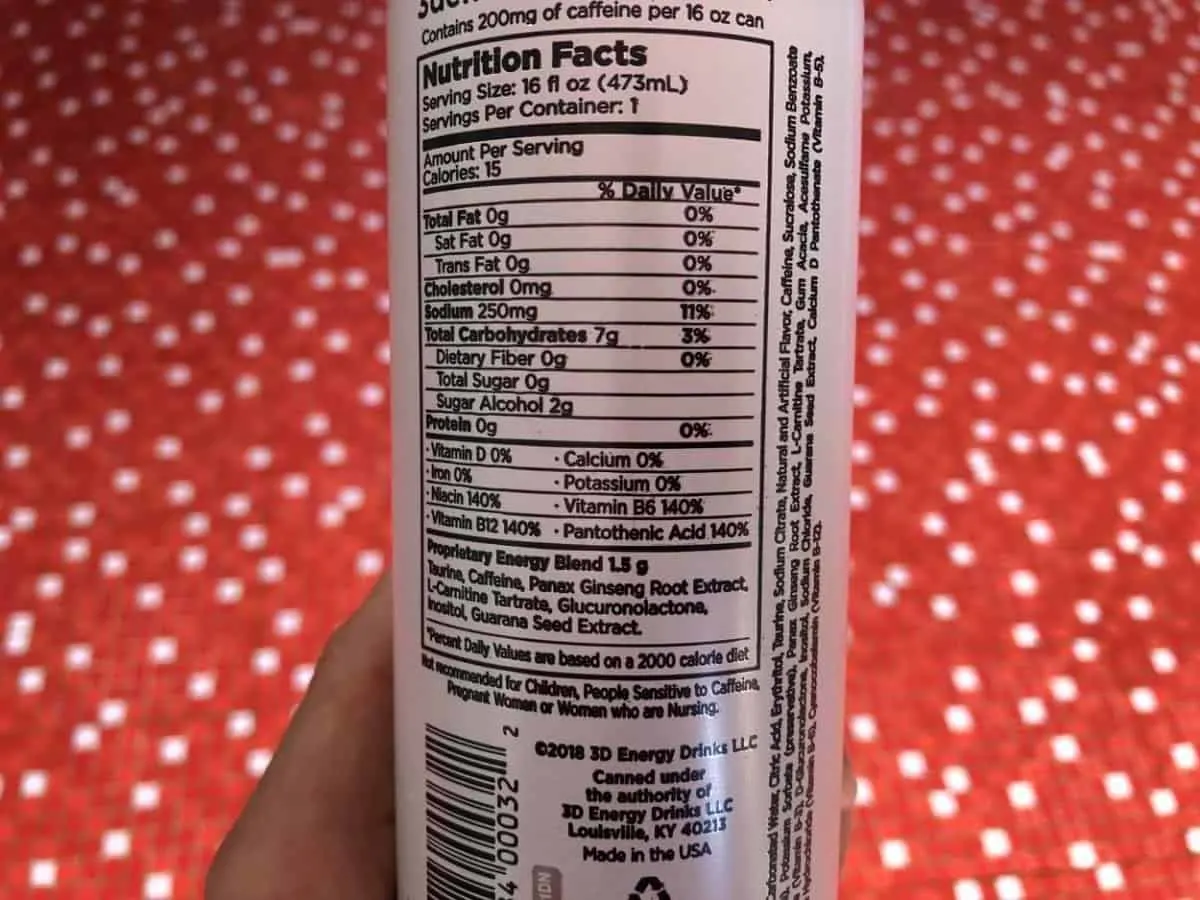Quick Answer: 3D Energy is gluten-free!
However, they are manufactured in facilities that might have come into contact with nuts, eggs, wheat, milk, and shellfish.
This means that if you’re living with gluten issues, you should take into consideration the manufacturing process of 3D Energy.
The good thing is, there isn’t any report of allergies and negative reactions after consuming 3D Energy.
So, we can assume that this drink is probably safe for people with gluten-related conditions.
Still, it’s worth investigating whether or not 3D Energy is gluten-free to ensure that it is safe for you to consume.
So, let’s jump straight onto the ingredients to see whether there are any gluten-based ingredients used on this beverage.

Page Contents
What is in 3D Energy Drink?
Here’s a quick rundown of 3D Energy Drink ingredients:
- Carbonated Water
- Citric Acid
- Erythritol
- Taurine
- Sodium Citrate
- Natural and Artificial Flavor
- Caffeine (200mg per can)
- Sucralose
- Sodium Benzoate
- Potassium Sorbate
- Panax Ginseng Root Extract
- L-Carnitine Tartrate
- Gum Acacia
- Acesulfame Potassium
- D-Glucuronolactone
- Inositol
- Sodium Chloride
- Guarana Seed Extract
- Niacinamide (Vitamin B3)
- Calcium D Pantothenate (Vitamin B5)
- Pyridoxine Hydrochloride (Vitamin B6)
- Cyanocobalamin (Vitamin B12)

None of the ingredients in this list contains gluten or is related to any gluten-based foods. In fact, a lot of them are synthetically produced in laboratories.
3D Energy Nutrition Facts

Based on the nutrition facts, there are no traces of gluten-based nutrients in 3D Energy.
Clearly, 3D Energy is packed with various vitamins that are all good for the body and works well as an energy booster.
Now, let’s see what gluten is and how many types of gluten intolerances are there. Shall we?
What is Gluten?

Gluten is an insoluble binding protein found in cereal grains like wheat, barley, and rye.
The chewy and stretchy texture you get from wheat-based foods like bread is because of the presence of gluten in them.
If you have gluten intolerance, you’ll have multiple reactions upon consumption of gluten, like bloating, stomach pain, and diarrhea.
Celiac disease, non-celiac gluten intolerance, and wheat allergy are a few examples of gluten-related conditions.
The reactions and symptoms of these three conditions slightly vary from each other, on which I’ll give a light explanation below.
Gluten-Related Health Problems
Celiac Disease
Celiac disease is a condition wherein ingestion of gluten triggers the digestive system leading to a damaged small intestine.
Gluten triggers the immune system and attacks the stomach lining that causes inflammation.
People with celiac disease face symptoms like:
- diarrhea
- constipation
- fatigue
- weight loss
- skin problems
- depression
To relieve these symptoms, following a strict gluten-free diet is the best way to go.
Non-celiac Gluten Sensitivity
Ingestion of gluten-containing food trigger non-celiac gluten sensitivity (NCGS) in the absence of wheat allergy and celiac disease.
The symptoms of NCGS overlap with those of wheat allergy and celiac disease making it even harder to tell. One way to diagnose this condition is through a double-blind placebo-controlled (DBPC) gluten challenge.
Here are the common symptoms of NCGS:
- nausea
- headache
- brain fog
- bloating
- diarrhea
- constipation
- fatigue
- joint pain
- abdominal pain
There is no definitive way to diagnose NCGS. So, it is best to consult a health professional to get recommendations on how you can change your diet plan.
Wheat Allergy
Wheat allergy is a type of allergic reaction due to one of the proteins found in wheat.
Allergy reactions may occur after inhaling wheat or taking it orally which can be noticeable within minutes or hours.
Anaphylaxis is one of the most serious symptoms of wheat allergy, which is a life-threatening allergic response. If you notice this symptom, seek immediate medical attention right there and then.
Other symptoms of wheat allergy include:
- eczema
- hives
- nausea
- diarrhea
- bloating
- asthma
- allergic rhinitis
- watery eyes
To help yourself and your doctor identify your wheat allergy condition, I suggest keeping a food diary noting all the food that you eat, time of consumption, and the symptoms that you have felt.
Watch this short clip to learn more about gluten!
What is a Gluten-Free Diet?
A gluten-free diet excludes all sorts of food containing wheat, barley, rye, or malt.
This type of diet is necessary for people suffering from gluten-related conditions. Other than that, it’s not really a treat for everybody.
However, nowadays, it’s seen that many people choose to avoid gluten despite not having any intolerance issues, with the idea of living a healthy lifestyle.
It must be taken into consideration that entirely cutting off gluten from your diet shrinks down your options. And if you don’t replace it with the right alternatives, you may be prone to malnutrition.
Nevertheless, if you’re able to find healthier alternatives, then avoiding gluten-based food is not a bad idea.
At the end of the day, it’s all up to you and your personal choice!
Is the Caffeine in 3D Energy Gluten-Free?
Yes, the caffeine in 3D Energy is gluten-free!
Caffeine is either obtained from coffee beans or is synthetically produced, none of which have any relation to wheat, barley, or rye.
Therefore, there is nothing to worry about the caffeine in 3D Energy Drink not being gluten-free.
For reference, a standard can of 3D Energy contains 200 mg caffeine.
Read here to learn more about 3D Energy ingredients.
However, it’s worth mentioning that just because it’s safe for your gluten-free diet, doesn’t mean it’s safe to consume caffeine in excess.
The FDA advises healthy adults to consume no more than 400 mg of caffeine in a single day.
Still, be mindful of your caffeine consumption to avoid jeopardizing your health.
Are the Artificial Sweeteners in 3D Energy Gluten-Free?
In my opinion, not all sweeteners in 3D Energy are gluten-free.
3D Energy uses the artificial sweeteners sucralose, acesulfame potassium, and erythritol which are all non-nutritive sweeteners.
Sucralose and acesulfame potassium are produced in laboratories through multistep chemical processes without the use of any gluten-related item.
However, erythritol is a kind of sugar alcohol that’s produced by the fermentation of glucose from corn or wheat starch.
Although the raw materials used for producing erythritol are wheat and corn, the ultimate product barely contains any kind of protein or gluten contamination.
Therefore, it can be concluded that the artificial sweeteners used by 3D Energy are absolutely gluten-free.
Still, you should be careful around these artificial sweeteners because they are associated with various health conditions including cancer.
Is the Taurine in 3D Energy Drink Gluten-Free?
Yes, it is!
Taurine is a kind of amino acid that is naturally produced in our bodies and is also one of the common ingredients in energy drinks like 3D.
Taurine is gluten-free and not in any way related to the protein found in cereal grains like wheat or barley.
Some of the benefits that you can obtain from taurine include:
- better heart health
- boosts exercise performance
- improved eyesight and hearing
- protect liver cells from free radicals
So, aside from taurine being free from gluten, it also brings potential benefits to your health. Pretty cool, right?
Is 3D Energy Drink Good For You?
It’s a rather tough question to answer but my reply would be it depends on how much you consume.
Consuming more than two cans of 3D Energy in a single day can potentially lead to caffeine overdose and trigger symptoms such as headaches, jitters, and diarrhea.
On the other hand, 3D Energy can give you a quick boost, and having one can a day is not that harmful to your health.
3D Energy is loaded with B-vitamins and minerals that work well in providing you a quick boost that would last a few hours.
Even though the minerals and other nutrients found in 3D Energy sounds good on paper, I still recommend sourcing it from a natural diet.
Also, keep in mind to always follow the suggested limit caffeine limit to avoid adverse effects.
How can I check if a product is gluten-free?
To verify if a product is gluten-free, start by examining its packaging for clear labels and certifications. Look for “gluten-free” labels or symbols from recognized organizations, such as the Gluten-Free Certification Organization (GFCO) or the Coeliac UK symbol.
Additionally, carefully read the ingredient list on the packaging. Avoid ingredients like wheat, barley, rye, and their derivatives, as they contain gluten. Some companies also include allergen information or statements about cross-contamination risks on their packaging.
Is there gluten in energy drinks?
In most cases, energy drinks do not contain gluten as a direct ingredient. The primary ingredients in energy drinks typically include water, caffeine, sugars, flavorings, and other additives. These ingredients themselves do not contain gluten. However, it’s important to be cautious about potential cross-contamination during the manufacturing process.
To ensure that an energy drink is gluten-free, look for products that are certified gluten-free by reputable organizations or have “gluten-free” labels on the packaging. Additionally, reading the ingredient list carefully and researching the brand’s manufacturing practices can provide insight into the potential risk of cross-contamination.
Alternatives to 3D Energy Drink
Here are some other gluten-free energy drinks that may be a good option for you:
- Red Bull
- Celsius
- Monster
- Mountain Dew AMP Energy
- NOS
- Mountain Dew Kickstart
- Venom
- 5-Hour Energy
- Game Fuel
Is 3D Energy Gluten-Free? (My Take)
So, we can all assume that 3D Energy is gluten-free since its company is very open about claiming it.
However, the fact that it might have come in contact with gluten-based items is something that is a little bit worrying for me.
Plus, erythritol, an artificial sweetener found in 3D Energy is manufactured by fermenting glucose.
These two points are something that really kind of put me off about 3D Energy.
The good news is, no negative reactions in connection to drinking 3D Energy have been recorded so far. So, we can all assume that it is a safe addition to a gluten-free diet.
Still, I suggest investigating the manufacturing process and ingredients of this particular drink before arriving at a definitive conclusion of whether or not it is free of gluten.
And after taking into account everything, that’s the perfect time for you to grab a can of 3D Energy!
